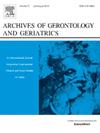Cardiovascular regulation during active standing orthostatic stress in older adults living with frailty: a systematic review
IF 3.8
3区 医学
Q2 GERIATRICS & GERONTOLOGY
引用次数: 0
Abstract
Background
Orthostatic hypotension (OH) is a relevant cardiovascular disorder associated with frailty and delayed cardiovascular regulatory responses, contributing to cardiovascular dysregulation. This dysregulation affects blood pressure (BP) control, increasing the risk of falls and mortality. This systematic review aimed to determine whether older adults living with frailty have impaired cardiovascular regulatory responses during active standing orthostatic stress.
Methods
MEDLINE (from 1946), PUBMED (from 1966), EMBASE (from 1974), CINAHL (from 1963), and SCOPUS (from 2004) were systematically searched for studies on cardiovascular regulation during active standing orthostatic stress in older adults living with frailty. The selection of studies involved the following criteria: ≥ 60 years, OH classification, continuous monitoring of beat-by-beat BP, active standing, and frailty status. The nine-point Newcastle-Ottawa Scale was used to assess the study quality.
Results
Of 7441 articles identified, 5 articles were included, but 3 independent data sets were extracted due to two studies reporting the same participants' cohort, resulting in an analysis of 726 participants (79±5 years, 41.7 % males). Frailty was associated with a greater drop in BP (-61 mmHg), blunted HR (Frail: 8 bpm; non-frail: 16 bpm), and longer recovery after active standing, occurring between 30–60 s instead of 0–30 s (healthy systems). OH prevalence ranged from 3 to 98 %, being higher in frail people.
Conclusions
Older adults living with frailty experience a greater drop in BP, a blunted HR response, and prolonged recovery time following active-standing orthostatic stress. This cardiovascular dysregulation contributes to the highest prevalence of OH among frail individuals.

生活虚弱的老年人站立站立时的心血管调节:一项系统综述
背景:稳压性低血压(OH)是一种相关的心血管疾病,与虚弱和心血管调节反应延迟相关,导致心血管失调。这种失调影响血压控制,增加跌倒和死亡的风险。本系统综述旨在确定老年人在主动站立站立时是否有心血管调节反应受损。方法系统检索medline(自1946年)、PUBMED(自1966年)、EMBASE(自1974年)、CINAHL(自1963年)和SCOPUS(自2004年),检索衰弱老年人站立站立应激时心血管调节的相关研究。研究的选择包括以下标准:≥60岁,OH分类,连续监测心跳血压,活动站立和虚弱状态。九分制纽卡斯尔-渥太华量表用于评估研究质量。结果在7441篇文献中,纳入了5篇文献,但由于两项研究报告了相同的受试者队列,因此提取了3个独立的数据集,结果分析了726名受试者(79±5岁,41.7%为男性)。虚弱与更大程度的血压下降(-61 mmHg)、HR减弱(虚弱:8 bpm;非虚弱:每分钟16次),活动站立后恢复时间更长,发生在30-60秒之间,而不是0-30秒(健康系统)。OH患病率从3%到98%不等,在体弱人群中更高。结论:成人体弱者在站立活动应激后血压下降幅度较大,HR反应减弱,恢复时间延长。这种心血管失调导致OH在身体虚弱的个体中发病率最高。
本文章由计算机程序翻译,如有差异,请以英文原文为准。
求助全文
约1分钟内获得全文
求助全文
来源期刊
CiteScore
7.30
自引率
5.00%
发文量
198
审稿时长
16 days
期刊介绍:
Archives of Gerontology and Geriatrics provides a medium for the publication of papers from the fields of experimental gerontology and clinical and social geriatrics. The principal aim of the journal is to facilitate the exchange of information between specialists in these three fields of gerontological research. Experimental papers dealing with the basic mechanisms of aging at molecular, cellular, tissue or organ levels will be published.
Clinical papers will be accepted if they provide sufficiently new information or are of fundamental importance for the knowledge of human aging. Purely descriptive clinical papers will be accepted only if the results permit further interpretation. Papers dealing with anti-aging pharmacological preparations in humans are welcome. Papers on the social aspects of geriatrics will be accepted if they are of general interest regarding the epidemiology of aging and the efficiency and working methods of the social organizations for the health care of the elderly.

 求助内容:
求助内容: 应助结果提醒方式:
应助结果提醒方式:


